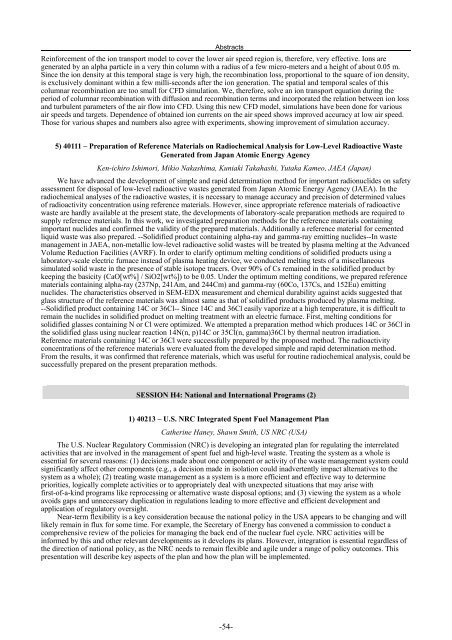ASME Message
ASME Message
ASME Message
Create successful ePaper yourself
Turn your PDF publications into a flip-book with our unique Google optimized e-Paper software.
Abstracts<br />
Reinforcement of the ion transport model to cover the lower air speed region is, therefore, very effective. Ions are<br />
generated by an alpha particle in a very thin column with a radius of a few micro-meters and a height of about 0.05 m.<br />
Since the ion density at this temporal stage is very high, the recombination loss, proportional to the square of ion density,<br />
is exclusively dominant within a few milli-seconds after the ion generation. The spatial and temporal scales of this<br />
columnar recombination are too small for CFD simulation. We, therefore, solve an ion transport equation during the<br />
period of columnar recombination with diffusion and recombination terms and incorporated the relation between ion loss<br />
and turbulent parameters of the air flow into CFD. Using this new CFD model, simulations have been done for various<br />
air speeds and targets. Dependence of obtained ion currents on the air speed shows improved accuracy at low air speed.<br />
Those for various shapes and numbers also agree with experiments, showing improvement of simulation accuracy.<br />
5) 40111 – Preparation of Reference Materials on Radiochemical Analysis for Low-Level Radioactive Waste<br />
Generated from Japan Atomic Energy Agency<br />
Ken-ichiro Ishimori, Mikio Nakashima, Kuniaki Takahashi, Yutaka Kameo, JAEA (Japan)<br />
We have advanced the development of simple and rapid determination method for important radionuclides on safety<br />
assessment for disposal of low-level radioactive wastes generated from Japan Atomic Energy Agency (JAEA). In the<br />
radiochemical analyses of the radioactive wastes, it is necessary to manage accuracy and precision of determined values<br />
of radioactivity concentration using reference materials. However, since appropriate reference materials of radioactive<br />
waste are hardly available at the present state, the developments of laboratory-scale preparation methods are required to<br />
supply reference materials. In this work, we investigated preparation methods for the reference materials containing<br />
important nuclides and confirmed the validity of the prepared materials. Additionally a reference material for cemented<br />
liquid waste was also prepared. --Solidified product containing alpha-ray and gamma-ray emitting nuclides--In waste<br />
management in JAEA, non-metallic low-level radioactive solid wastes will be treated by plasma melting at the Advanced<br />
Volume Reduction Facilities (AVRF). In order to clarify optimum melting conditions of solidified products using a<br />
laboratory-scale electric furnace instead of plasma heating device, we conducted melting tests of a miscellaneous<br />
simulated solid waste in the presence of stable isotope tracers. Over 90% of Cs remained in the solidified product by<br />
keeping the basicity (CaO[wt%] / SiO2[wt%]) to be 0.05. Under the optimum melting conditions, we prepared reference<br />
materials containing alpha-ray (237Np, 241Am, and 244Cm) and gamma-ray (60Co, 137Cs, and 152Eu) emitting<br />
nuclides. The characteristics observed in SEM-EDX measurement and chemical durability against acids suggested that<br />
glass structure of the reference materials was almost same as that of solidified products produced by plasma melting.<br />
--Solidified product containing 14C or 36Cl-- Since 14C and 36Cl easily vaporize at a high temperature, it is difficult to<br />
remain the nuclides in solidified product on melting treatment with an electric furnace. First, melting conditions for<br />
solidified glasses containing N or Cl were optimized. We attempted a preparation method which produces 14C or 36Cl in<br />
the solidified glass using nuclear reaction 14N(n, p)14C or 35Cl(n, gamma)36Cl by thermal neutron irradiation.<br />
Reference materials containing 14C or 36Cl were successfully prepared by the proposed method. The radioactivity<br />
concentrations of the reference materials were evaluated from the developed simple and rapid determination method.<br />
From the results, it was confirmed that reference materials, which was useful for routine radiochemical analysis, could be<br />
successfully prepared on the present preparation methods.<br />
SESSION H4: National and International Programs (2)<br />
1) 40213 – U.S. NRC Integrated Spent Fuel Management Plan<br />
Catherine Haney, Shawn Smith, US NRC (USA)<br />
The U.S. Nuclear Regulatory Commission (NRC) is developing an integrated plan for regulating the interrelated<br />
activities that are involved in the management of spent fuel and high-level waste. Treating the system as a whole is<br />
essential for several reasons: (1) decisions made about one component or activity of the waste management system could<br />
significantly affect other components (e.g., a decision made in isolation could inadvertently impact alternatives to the<br />
system as a whole); (2) treating waste management as a system is a more efficient and effective way to determine<br />
priorities, logically complete activities or to appropriately deal with unexpected situations that may arise with<br />
first-of-a-kind programs like reprocessing or alternative waste disposal options; and (3) viewing the system as a whole<br />
avoids gaps and unnecessary duplication in regulations leading to more effective and efficient development and<br />
application of regulatory oversight.<br />
Near-term flexibility is a key consideration because the national policy in the USA appears to be changing and will<br />
likely remain in flux for some time. For example, the Secretary of Energy has convened a commission to conduct a<br />
comprehensive review of the policies for managing the back end of the nuclear fuel cycle. NRC activities will be<br />
informed by this and other relevant developments as it develops its plans. However, integration is essential regardless of<br />
the direction of national policy, as the NRC needs to remain flexible and agile under a range of policy outcomes. This<br />
presentation will describe key aspects of the plan and how the plan will be implemented.<br />
-54-


